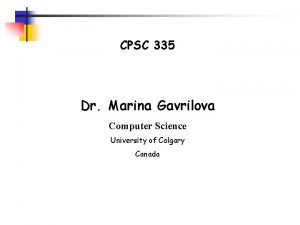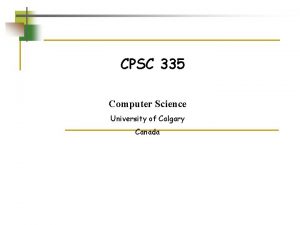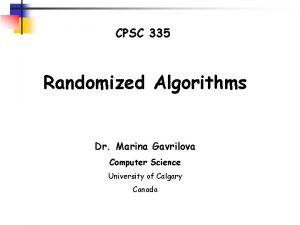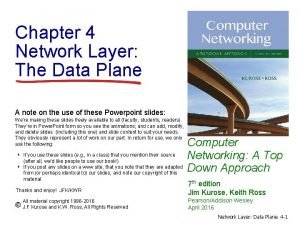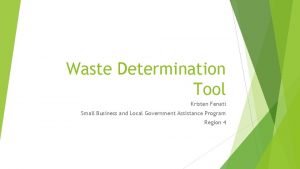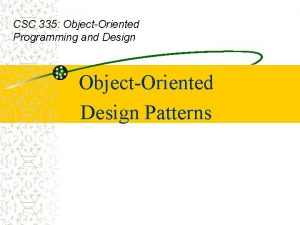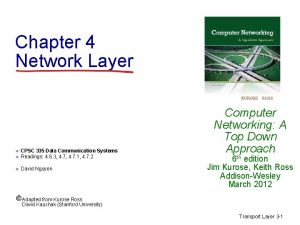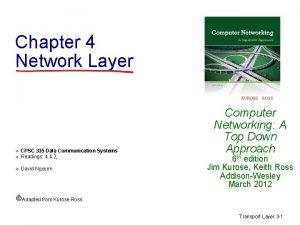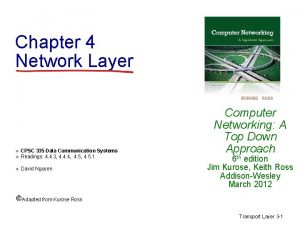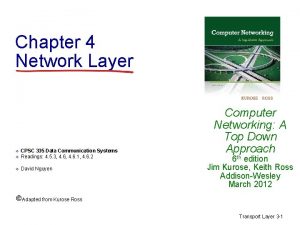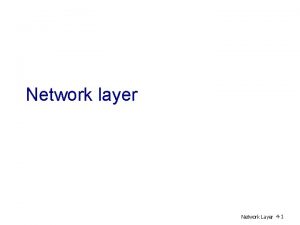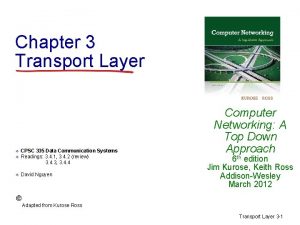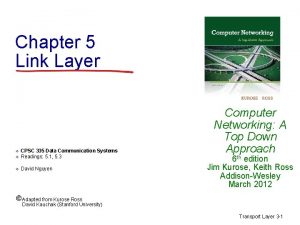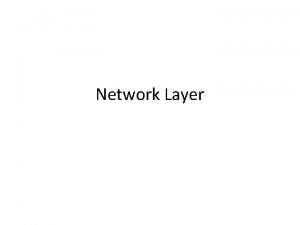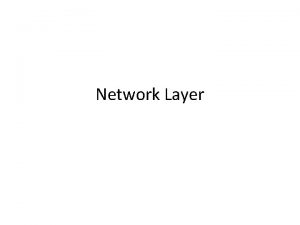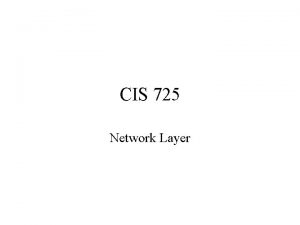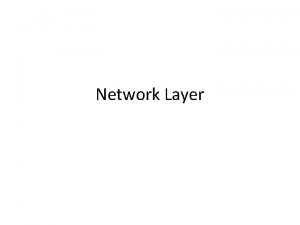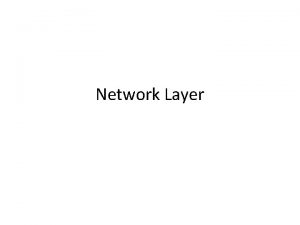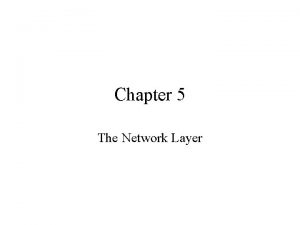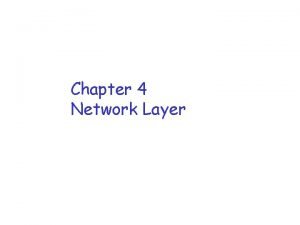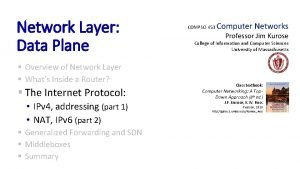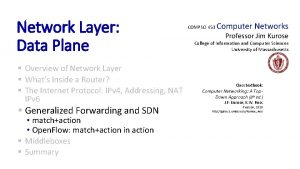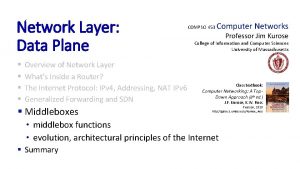Chapter 4 Network Layer v CPSC 335 Data























- Slides: 23

Chapter 4 Network Layer v CPSC 335 Data Communication Systems Readings: 4. 5. 3, 4. 6. 1, 4. 6. 2 v David Nguyen v Computer Networking: A Top Down Approach 6 th edition Jim Kurose, Keith Ross Addison-Wesley March 2012 Adapted from Kurose Ross Transport Layer 3 -1

Chapter 4: outline 4. 1 introduction 4. 2 virtual circuit and datagram networks 4. 3 what’s inside a router 4. 4 IP: Internet Protocol § § datagram format IPv 4 addressing ICMP IPv 6 4. 5 routing algorithms § link state § distance vector § hierarchical routing 4. 6 routing in the Internet § RIP § OSPF § BGP 4. 7 broadcast and multicast routing Network Layer 4 -2

Hierarchical routing our routing study thus far - idealization v all routers identical v network “flat” … not true in practice scale v v can’t store all dest’s in routing tables! routing table exchange would swamp links! administrative autonomy v v internet = network of networks each network admin may want to control routing in its own network Network Layer 4 -3

Hierarchical routing v v aggregate routers into regions, “autonomous systems” (AS) routers in same AS run same routing protocol gateway router: v v at “edge” of its own AS has link to router in another AS § “intra-AS” routing protocol § routers in different AS can run different intra -AS routing protocol Network Layer 4 -4

Interconnected ASes 3 c 3 a 3 b AS 3 2 a 1 c 1 a 1 d 2 c AS 2 1 b AS 1 Intra-AS Routing algorithm Inter-AS Routing algorithm Forwarding table v 2 b forwarding table configured by both intraand inter-AS routing algorithm § intra-AS sets entries for internal dests § inter-AS & intra-AS sets entries for external dests Network Layer 4 -5

Inter-AS tasks v suppose router in AS 1 receives datagram destined outside of AS 1: § router should forward packet to gateway router, but which one? AS 1 must: 1. learn which dests are reachable through AS 2, which through AS 3 2. propagate this reachability info to all routers in AS 1 job of inter-AS routing! 3 c 3 b other networks 3 a AS 3 1 c 1 a AS 1 1 d 2 a 1 b 2 c 2 b other networks AS 2 Network Layer 4 -6

Example: setting forwarding table in router 1 d v suppose AS 1 learns (via inter-AS protocol) that subnet x reachable via AS 3 (gateway 1 c), but not via AS 2 § inter-AS protocol propagates reachability info to all internal routers v router 1 d determines from intra-AS routing info that its interface I is on the least cost path to 1 c § installs forwarding table entry (x, I) … 3 c 3 b other networks x 3 a AS 3 1 c 1 a AS 1 1 d 2 a 1 b 2 c 2 b other networks AS 2 Network Layer 4 -7

Example: choosing among multiple ASes v v now suppose AS 1 learns from inter-AS protocol that subnet x is reachable from AS 3 and from AS 2. to configure forwarding table, router 1 d must determine which gateway it should forward packets towards for dest x § this is also job of inter-AS routing protocol! … 3 c 3 b other networks x … … 3 a AS 3 1 c 1 a AS 1 2 a 1 d 1 b 2 c 2 b other networks AS 2 ? Network Layer 4 -8

Example: choosing among multiple ASes v v now suppose AS 1 learns from inter-AS protocol that subnet x is reachable from AS 3 and from AS 2. to configure forwarding table, router 1 d must determine towards which gateway it should forward packets for dest x § this is also job of inter-AS routing protocol! v hot potato routing: send packet towards closest router and it will figure out learn from inter-AS protocol that subnet x is reachable via multiple gateways use routing info from intra-AS protocol to determine costs of least-cost paths to each of the gateways hot potato routing: choose the gateway that has the smallest least cost determine from forwarding table the interface I that leads to least-cost gateway. Enter (x, I) in forwarding table Network Layer 4 -9

Chapter 4: outline 4. 1 introduction 4. 2 virtual circuit and datagram networks 4. 3 what’s inside a router 4. 4 IP: Internet Protocol § § datagram format IPv 4 addressing ICMP IPv 6 4. 5 routing algorithms § link state § distance vector § hierarchical routing 4. 6 routing in the Internet § RIP § OSPF § BGP 4. 7 broadcast and multicast routing Network Layer 4 -10

Intra-AS Routing v most common intra-AS routing protocols: § RIP: Routing Information Protocol § OSPF: Open Shortest Path First Network Layer 4 -11

RIP ( Routing Information Protocol) v v included in BSD-UNIX distribution in 1982 distance vector algorithm § distance metric: # hops (max = 15 hops), each link has cost 1 § DVs exchanged with neighbors every 30 sec in response message (aka advertisement) § each advertisement: list of up to 25 destination subnets (in IP addressing sense) from router A to destination subnets: u v A z C B D w x y subnet u v w x y z hops 1 2 2 3 3 2 Network Layer 4 -12

RIP: example z w x A B D y C routing table in router D destination subnet next router # hops to dest w y z x A B B -- 2 2 7 1 …. . . Network Layer 4 -13

RIP: example dest w x z …. w A-to-D advertisement next hops 1 1 C 4 …. . . x A z B D y C routing table in router D destination subnet next router # hops to dest w y z x A B -- 2 2 5 7 1 …. . . Network Layer 4 -14

RIP: link failure, recovery if no advertisement heard after 180 sec --> neighbor/link declared dead § routes via neighbor invalidated § new advertisements sent to neighbors § neighbors in turn send out new advertisements (if tables changed) § link failure info propagates to entire net Network Layer 4 -15

RIP table processing RIP routing tables managed by application-level process called route-d (daemon) v advertisements sent in UDP packets, routed repeated routed periodically v transport (UDP) network (IP) forwarding table link physical transprt (UDP) forwarding table network (IP) link physical Network Layer 4 -16

OSPF (Open Shortest Path First) “open”: publicly available v uses link state algorithm v § LS packet dissemination § topology map at each node § route computation using Dijkstra’s algorithm OSPF advertisement carries one entry per neighbor v advertisements flooded to entire AS v Network Layer 4 -17

OSPF “advanced” features (not in RIP) security: all OSPF messages authenticated (to prevent malicious intrusion) v multiple same-cost paths allowed (only one path in RIP) v hierarchical OSPF in large domains. v Network Layer 4 -18

Hierarchical OSPF boundary router backbone area border routers area 3 internal routers area 1 area 2 Network Layer 4 -19

How to get a dream job at big IT companies? Tips based on personal experience and “Cracking the Coding Interview” GOOGLE AND AMAZON INTERVIEW TIPS! Transport Layer 3 -20

Behavioral Questions to get to know your personality v deeply understand your resume v to ease you into an interview v usually of the form “tell me about a time when you. . . ” v Recommend filling this table v Transport Layer 3 -21

Behavioral Questions Do the similar table with major aspects of your resume (jobs, …) v Study the tables before the interview v Additional advice v § When asked about your weaknesses, give a real weakness! (I work too hard / am a perfectionist - arrogant) § When asked what the most challenging part was, don’t say “I had to learn a lot of new languages and technologies. ” (means nothing was really that hard) Transport Layer 3 -22

Sample theory questions (Google) What are the differences between TCP and UDP? (should be easy for you now : ) v Explain what happens, step by step, after you type a URL into a browser. Use as much detail as possible. (piece of cake again) v Transport Layer 3 -23
 Cpsc 335
Cpsc 335 Cpsc 335
Cpsc 335 Cpsc 335
Cpsc 335 Comparison of virtual circuit and datagram subnets
Comparison of virtual circuit and datagram subnets Network layer data plane
Network layer data plane Csc 335
Csc 335 Cmsc 335
Cmsc 335 Comp335
Comp335 Cmsc 335
Cmsc 335 30 tac 335
30 tac 335 30 tac 335
30 tac 335 30 tac 335
30 tac 335 Sim 335
Sim 335 Psy 335 purdue
Psy 335 purdue Csc 335
Csc 335 Pigmented layer and neural layer
Pigmented layer and neural layer Parietal layer and visceral layer
Parietal layer and visceral layer Secure socket layer and transport layer security
Secure socket layer and transport layer security Presentation layer functions
Presentation layer functions Secure socket layer and transport layer security
Secure socket layer and transport layer security Secure socket layer and transport layer security
Secure socket layer and transport layer security Secure socket layer and transport layer security
Secure socket layer and transport layer security Layer 2 e layer 3
Layer 2 e layer 3 Layer-by-layer assembly
Layer-by-layer assembly
